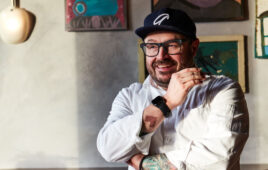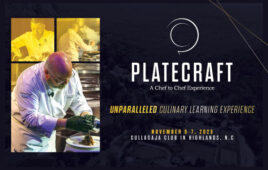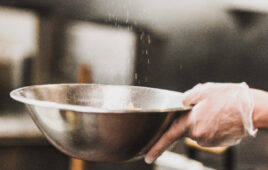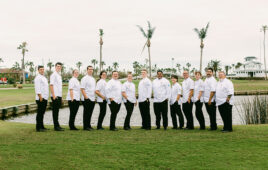 Executive Chef Harold Sena-Akoto—and the membership he’s served for 11 years—has yet to meet a cuisine he can’t prepare, and they won’t love.
Executive Chef Harold Sena-Akoto—and the membership he’s served for 11 years—has yet to meet a cuisine he can’t prepare, and they won’t love.
Ruby Hill Golf Club, in Pleasanton, Calif., features a Jack Nicklaus Signature Design course nestled in the scenic hills of the Livermore Valley, in the East Bay Area near San Francisco. In addition to great golf, tennis and a large pool complex, a unique draw for the club is the game of bocce, played on authentic courts adjacent to Ruby Hill’s Italian villa-style clubhouse.
The chef at Ruby Hills GC for the past eleven years has been Harold Sena-Akoto, a native of Accra, Ghana in West Africa. Harold is as proud of his heritage as he is of his cuisine; when introducing himself, he often includes friendly reminders that Ghana’s soccer team eliminated the U.S. in the past two World Cups.
That’s just one part of an outgoing personality that has always made Chef Sena-Akoto popular among the Ruby Hill membership—and now, under a new General Manager, Chris Stewart, and new Food & Beverage Director, Tom Field, Harold is being encouraged to use his skills with spice mixtures and other techniques in new ways, to make the flavors of his food really stand out. Our conversation with Chef Sena-Akoto provided insights into how the new spirit of Ruby Hill is now being reflected in exciting new directions for the club’s culinary program—and providing new opportunities for Harold to make full use of his worldwide experience and creative abilities.
Q: Chef, how have things changed for you and the culinary program at Ruby Hill after the arrival of a new General Manager?
A: It is very satisfying to have a General Manager who sees food in the same light as a Chef. I can really channel my creativity into things like the chef-recommended specials for our Friday night a la carte dining. It can be hectic to create those extra dishes, especially during our busy bocce season, but we’ve developed a growing following for them that makes it worthwhile. I’ve also developed African and Indian wedding menus that help add even more variety and choices for our wedding business [Ruby Hill has nearly 60 weddings a year and does not have a la carte dining on Saturday nights, because of its steady wedding business].
Q: With your tenure and great reputation for your food, you’ve earned the trust of your membership, and that means you can write appropriate menus for regular club events without having to always get approval for their content. This is something many club chefs can’t do. How much of a difference can it make for helping to control waste, because you can funnel an extra tenderloin or side of salmon to a group that you know will love it?
A: This is a golden opportunity, commonly referred to as “Chef’s choice,” that all clubs should give major attention to. In my kitchen, we actually refer to it as “creative Chef’s choice.” Having this leeway helps me and my staff not only use extra products, but create value-added meals from our regular inventory. I have found that channeling these items in this way can help to shave off 2 or 3 percentage points from the cost of food for member events. But there is one very important caution about this practice: Make sure you also pay even more attention to creating a good meal out of these items.
Q: What other steps have you taken to help attain food-cost goals?
A: Again, I have to say I have been quite lucky in that we have introduced a lot of activities at the club that have high participation among the members, such as bocce, summer wine tastings, Italian nights, Asian nights, Indian nights and Mexican theme nights. These events allow me to use extra products and non-moving stock to create new menu items and reduce waste. Special-event and banquet-event pricing can also help to stabilize food cost percentages, on average.
I have also instituted a waste control system, through which the Sous Chef inspects and spot-checks food items at the end of each shift, to ensure that products are properly put away. Portion control is another challenge—it can vary for many reasons, including differences in staff practices. I have minimized that by making sure that inspection and cutting of protein portions is usually done by myself, the Sous Chef or the Assistant Chef.
I am also lucky that here in California, we are surrounded by good seasonal produce. Orders are usually made every day, at the end of the evening shift.
In-house preparation is another major part of cost control, and having an accomplished pastry chef who has been here a long time with me, Lessa Castaneda, has also played a major role in that. I have also noticed that a high turnover rate in kitchen staff will play a role in waste and affect the bottom line.
I would like to think that my staff is trained well to understand the concept of food costs. I always let them know that the cost of a botched order of food will be written off, but they will have to give me a good explanation of why the order was not made correctly.
The kitchen staff is also well-trained to use low-cost and slow-moving stock to create specials with high perceived value. These can eventually end up on our main menu, with the items named after the staff person who created them. For example, a soft taco named after one of my employees that uses prime rib and is priced at eighteen dollars has become a very popular item on our menu.
Q: Your winemaker dinners sound awesome. Can you run us through your philosophy for writing these menus with multiple courses, where portion sizes are so important, and share other tricks for making these dinners special?
A: Winemaker dinners offer a good way to introduce new things and try items that are out of the ordinary, and at the same time be creative. I take the price point of the wine to be used into consideration first, bearing in mind that our price point for the dinners will not exceed $100 per person. With high-cost wines, I start the cocktail hour by channeling extra items that we have in stock and creating interesting hors d’oeuvres out of them.
My first-, second- and sometimes third-course items are always the most interesting ones, where my inspiration takes charge and I introduce new dishes with complex flavors. The portions for these courses are very small, and attention is paid to presentation.
I usually end wine dinners with items members are familiar with, like ribeye, beef tenderloin or wild game; these portions are slightly larger, around six ounces. One rule of thumb I have when developing menus for wine pairings is to avoid fatty ingredients. If I can, I use ingredients that “grow up” with the wines; for example, seasonings and ingredients from Australia for Australian wine dinners. I have also found that incorporating the wines being served into the sauces that go with the meal helps to further enhance the flavor combinations.
Q: Finally, Chef, you and I have both been at our clubs for a little over ten years. How would you describe the evolution of how members have come to perceive you, and the quality of your cuisine has developed over the last decade?
A: It is always nerve-racking and a challenge when you take charge of a new kitchen and have to think about changing a menu that members are used to, training staff, and knowing that members are anxious to meet you and taste your meals.
When I came to Ruby Hill, I was lucky enough to have members who were by-and-large welcoming and accommodating enough to give me room to be creative with my menus. I’ve also had the pleasure of being permitted to buy only the best quality ingredients to start with. This all combined to give me the confidence to consistently put out very interesting and flavorful meals from my earliest years at the club. Then the challenge becomes one of maintaining the quality and consistency of those dishes on an everyday basis, and that is where training of kitchen staff comes into play.
Even though I think that the members’ perception of me is a good one and that our profession has been awarded a great deal of respect, with that still comes the responsibility to always create a comfortable atmosphere of good food, value and listening to the members. More often than not, we also tend to forget about the children of our members—if you ask them how their meals are and how you can improve them, these children will give you an honest answer. I always try to do my best in this area, and I like to think it earns me bonus points from the members’ perspective.
Recipes by Harold Sena-Akoto, Executive Chef, Ruby Hill Golf Club, Pleasanton, Calif.:
Orange Crème Brulee in Orange Cup
Charred Sea Bass With Essence of Lemongrass, Sautéed Broccoli and Cherry Tomato Porcini Butter
View Ruby Hill GC’s Weekend Menu
View Ruby Hill GC’s Lunch Menu





